
In this week’s edition of Origins, we will take a deep dive into how President Franklin Delano Roosevelt’ New Deal initiatives helped influence ski areas and mountain towns. If you missed last week’s edition of Origins on heli-skiing, check it out here:
- Related: Origins: Heli-skiing
The New Deal was a series of programs and institutions created during the Great Depression by President Franklin Delano Roosevelt. Among the list of new programs was the Civilian Conservation Corps (CCC) created on April 5, 1933, via an Executive Order. Widely regarded as one of the most successful such work programs implemented under The New Deal, it provided work for hundreds of thousands on environmental projects.
Most of the men employed under the CCC lived in the eastern cities of the country, but most of the work was in the west. The army helped solve transportation and logistical concerns for moving the workers to the project sites. By July 1, 1933, roughly 1,400 work camps housing over 300,000 men were established and put to work. This is considered the most rapid peacetime mobilization of the U.S. Army in history.

The men at these camps did a variety of different jobs that included: planting trees, building highways, erosion mitigation, fighting forest fires, re-seeding grazing lands, building shelters, implementing winter sports activity infrastructure, and maintenance of access roads. Some of the highways and roads they built help create access to areas that we now call ski resorts. Alta/Snowbird, Brighton, and Solitude in Utah were beneficiaries of some of these projects.
Civilian Conservation Corp company 3340 worked out of the F-38 camp located in Big Cottonwood Canyon helped build bridges, roads, campgrounds, ski facilities, amphitheaters among other projects. Not only did this camp service Big Cottonwood Canyon, but also worked on projects in Little Cottonwood Canyon, Mill Creek Canyon, and the Wasatch front east of Salt Lake City. One of the notable projects from this camp was the building of Alta Ski Resort Lodges. The Snowpine Lodge and Alta Lodge were constructed as the first overnight lodging in the area. While additions and renovations have been made to these lodges throughout the years, they are still in use to this day.

Utah was not the only beneficiary of the CCC in the wintersports space. Some ski areas that were a direct beneficiary of these New Deal Programs were Badger Pass Ski Area (Yosemite National Park, CA), Beartown State Forest Ski Areas (Monterrey, MA), Cannon Mountain Ski Area (Franconia, NH), Lake Placid (Lake Placid, NY), Mohawk Mountain Ski Area (Cornwall CT), Wildcat Mountain Ski Area (NH), Warner Mountain (MA), among other backcountry improvements and rope tow installations. These projects helped widen and improve roads, clear trails, build shelters and implement ski tows. The Paradise Ski-Tow on Mt. Rainier is one of the more notable ski tows implemented that did not result in a permanent ski area.

These New Deal Programs helped not only clear the path for a prospering ski industry in the United States, but also helped provide jobs to hundreds of thousands during the peak of The Great Depression. They helped revive small towns across the country and provided crucial outdoor infrastructure that is still in use today.
I could not possibly touch on every project that The New Deal and CCC were a part of in one article. If you would like to see a comprehensive list of projects check out The Living New Deal’s website!
Not sure where you are getting this information from? Soda Springs was operating in 1931, but by your concern it’s not a ski area unless it has a lift? Soda Springs officially opened in 1935 with rope tows, Badger pass didn’t have their lift running until 1936.
Come on guys, do some fact checking, you can’t change history for his story.
Prior to the enviro whacks shutting down the ability to build new ski resorts.
Granlibakken Ski Area open in 1927, eight years before Badger Pass.
Hi Mike! Granlibakken did open in 1927, but Badger Pass is considered the first “alpine ski resort” in California. Granlibakken did have skiing but it did not have any form of lift and mainly hosted cross-country skiing and ski jumping activities. Guests were mainly moved with sleds while Badger pass had rope tows and eventually chairlifts both before Granlibakken. Sorry for the confusion but it was meant to say “alpine ski resort”.
Here is a older Snowbrains post that states Granlibakken was the FIRST US ski resort to open in 1927. So, what’s it going to be?